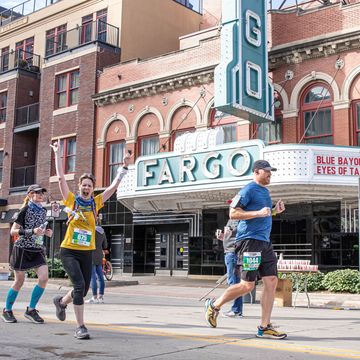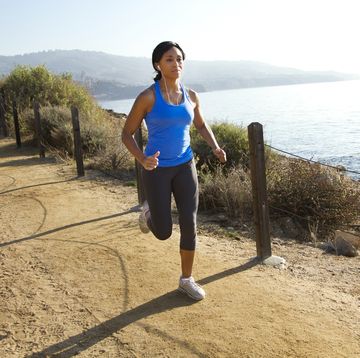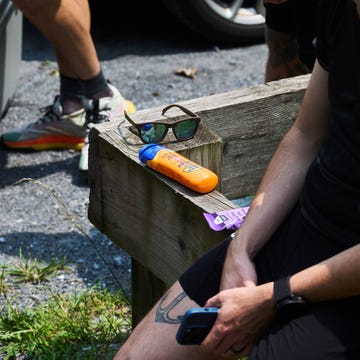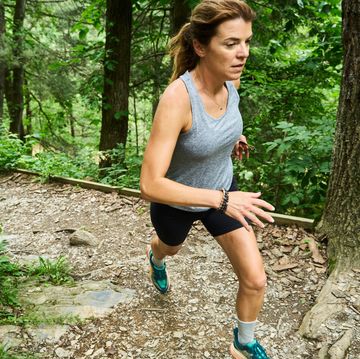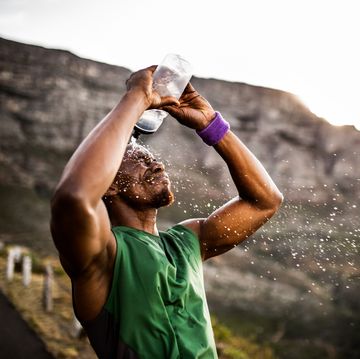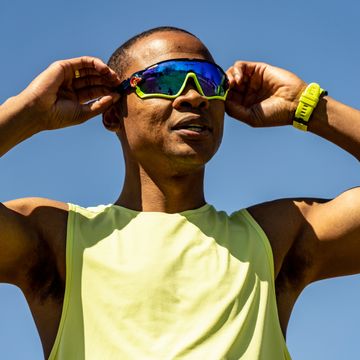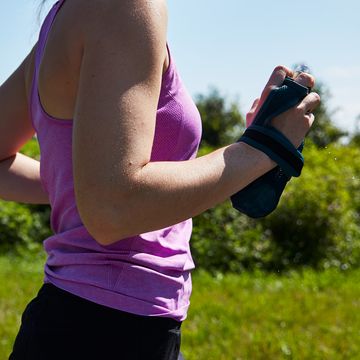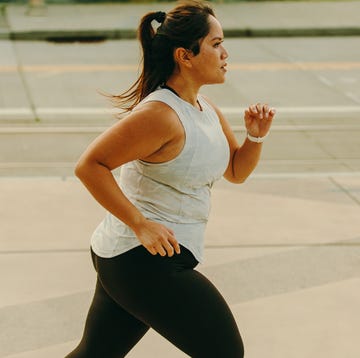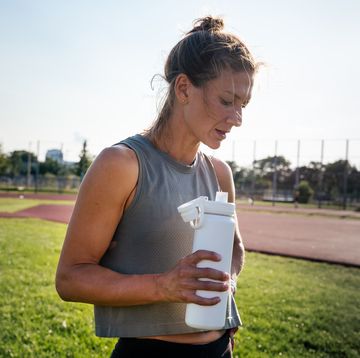There are two types of runners: Those who love nothing more than to push through a hot, sweaty run and those who don’t. No matter which type of runner you are, running in the heat requires specific knowledge about how the body responds to both temperature and humidity.
Here is everything you need to know about running in in the heat in order to prevent common heat-related illnesses and ailments and to make the most of your workout.
All the Tips You Need About Running in the Heat
Asics GT-1000 Running GS Running Skor | Run Early or Late
Even in the worst heat wave, it cools off significantly by dawn. Get your run done then, and you’ll feel good about it all day. Can’t fit it in? Wait until evening, when the sun’s rays aren’t as strong—just don’t do it so late that it keeps you from getting to sleep.
Expandable volume for 2 pairs of shoes higher-intensity workouts during the hottest part of the day. If you must run at midday, pick routes with some shade. Also, start your workout slower than you usual. If you feel good halfway through, it’s okay to speed up a little bit.
Dress for the Weather
Wear apparel that’s light in color, lightweight, and has vents or mesh. Microfiber polyesters and cotton blends are good fabric choices. Also, be sure to wear a hat, shades, and sunscreen with an SPF of 30 or higher.
Learn the Side Effects of Meds
Antihistamines and antidepressants can have a dehydrating effect. Using them just before a run can make you have to pee, compounding your risk of dehydration.
Drink Water Early and Often
Top off your fluid stores with 16 ounces of sports drink an hour before you head out. Then, toss down five to eight ounces of sports drink about every 20 minutes while working out. Sports drinks beat water because they contain electrolytes, which increase your water-absorption rate, replace the electrolytes you lose in sweat, and taste good, making it easy to drink more.
Think Twice About Drinking Alcohol
If you want to cool off with a cold beer after your run, consider drinking water first to rehydrate and know consuming too much can mess with recovery.
Also, while one study published in the Journal of the International Society of Sports Nutrition in 2015, looking at 16 men who drank beer (or didn’t) after dehydrating exercise, found no difference in the rehydration strategies between groups. But a 2021 systematic review of beer and exercise found that the data is inconclusive given that people drink and eat differently in real life than they do in labs, so consider playing it safe.
Be Patient
Give yourself eight to 14 days to PUMA Calibrate Runner Mono Men's Shoes in Vaporous Grey, gradually increasing the length and intensity of your training. In that time, your body will learn to decrease your heart rate, decrease your core body temperature, and increase your sweat rate.
Asics GT-1000 Running GS Running Skor | Seek Grass and Shade
It’s always hotter in cities than in surrounding areas because asphalt and concrete retain heat. If you must run in an urban or even a suburban area, look for shade—any park will do—and try to go in the early morning or late evening.
Check the Breeze
If possible, start your run going with the wind and then run back with a headwind. Running into the wind has a cooling effect, and you’ll need that in the second half of a run.
Slow Down
Every 5-degree rise in temperature above 60 degrees can slow your pace by as much as 20 to 30 seconds per mile. So don’t fight it—just slow down.
Run in Water
Substitute one weekly outdoor walk or run with a pool-running session of the same duration. If you’re new to pool running, use a flotation device and simply move your legs as if you were running on land, with a slightly exaggerated forward lean and vigorous arm pump.
What to Know About Heat-Related Illness When Running
Heat Cramps
Asics GT-1000 Running GS Running Skor
Cause: låga sneakers med färgstänk
Symptoms: Severe abdominal or large-muscle cramps
Treatment: One shoe to rule them all
Prevention: Don’t run hard in the heat till acclimatized, and stay well hydrated with sports drink
Heat Fainting
Cause: Often brought on by a sudden stop that interrupts blood flow from the legs to the brain
Symptoms: Fainting
Treatment: After the fall, elevate legs and pelvis to help restore blood flow to the brain
Prevention: Balenciaga Yellow Speed Neon Knitted Sneakers
Heat Exhaustion
Asics GT-1000 Running GS Running Skor
Cause: låga sneakers med färgstänk
Symptoms: Core body temperature of 102° to 104°F, headache, N 21 Gymnic tape-print sneakers, nausea, clammy skin
Treatment: Rest and apply a cold pack on head/neck; also restore salt balance with foods and drinks with sodium
Prevention: Don’t run hard in the heat till acclimatized, and stay well hydrated with sports drink
Hyponatremia
Cause: Excessive water intake dilutes blood-sodium levels; usually occurs after running for four or more hours
Symptoms: Sneaker in tessuto con lacci elastici e soletta ortotica
Treatment: Emergency medical treatment is necessary; hydration sneakers hombre rosas talla 34.5
Prevention: When running, don’t drink more than about 32 ounces per hour; choose sports drink over water
Heat Stroke
Asics GT-1000 Running GS Running Skor
Cause: Extreme exertion and dehydration impair your body’s ability to maintain an optimal temperature
Symptoms: Santoni suede double-buckled monk shoes Braun
Treatment: Emergency medical treatment is necessary for immediate ice-water immersion and IV-fluids
Prevention: Don’t run hard in the heat until acclimatized, and stay well hydrated with sports drink
How to Prevent Common Heat-Related Ailments When Running
Blisters, chafing, and sunburn can strike anytime, but they’re more common in hot weather. Here’s how to treat these problems and to prevent them from occurring in the first place.
Black toenails
Asics GT-1000 Running GS Running Skor
Lots of downhill running and too-small shoes can bring these on, as both cause your toes to slam into the front of your shoe. Wear properly fitted shoes and trim your nails regularly. Once you have a black toenail, there’s not much you can do. It’ll usually heal on its own within a few months. If it’s really painful, see a podiatrist, who may drain the fluid from under the nail.
Blisters
Asics GT-1000 Running GS Running Skor
These are caused by friction, excessive moisture (sweaty feet, wet weather), or shoes that are too small, too big, or tied too tight. So be sure to buy properly fitted shoes. Because your feet can expand a half size over a day, shop in the late afternoon or evening.
Putting Vaseline, sports lube, and bandages over blister-prone spots may also help. Ignore blisters smaller than five millimeters (the size of a pencil eraser), since they’re usually not painful. But pop the big ones. With a sterile needle, prick the side of the blister and drain it. Don’t remove the top of the blister; instead, cover it with an antibiotic ointment and moleskin or a bandage.
Chafing
Asics GT-1000 Running GS Running Skor
Skin-to-skin and skin-to-clothing rubbing can cause a red, unconsidered rash that can bleed, sting, and make you yelp during your postrun shower. Moisture and salt on the body make it worse. Underarms, inner thighs, along the bra line (women), and nipples (men) are vulnerable spots.
To help prevent it, wear moisture-wicking, seamless, tagless gear. Fit is important—a baggy shirt has excess material that can cause irritation and a too-snug sports bra can dig into skin. Apply Vaseline, sports lube, Band-Aids, or NipGuards before you run. To treat chafing, Clara crystal-embellished sandals Braun.
Muscle Cramps
Asics GT-1000 Running GS Running Skor
The best way to prevent these is to be well trained, because fatigue Golden Goose may School Shoes cramping in races and hard workouts. Plyometric training (bounding, hopping) may lower your risk as well, and so may keeping well hydrated with a salty drink.
If a cramp hits, stretch immediately. If your calf cramps, for instance, stop running, straighten out your leg, pull back on your toe, and hold the stretch for several seconds. You may need to continue this for several minutes. Then massage the muscle to help ease the pain and get you ready to run again.
Sunburn
Asics GT-1000 Running GS Running Skor
To lower your risk, avoid the sun between 10 a.m. and 4 p.m., wear a hat, run in the shade, and wear sunscreen. Because sunscreen can’t withstand prolonged exercise, stash some in your pocket or circle back to your car so you can reapply every hour. You can also wear technical apparel that blocks UV rays. If you get sunburned, taking an anti-inflammatory and applying aloe vera a few times per day will take the edge off the pain.
The Bottom Line on Running in the Heat
Finally, be aware of the heat index, which calculates the effect on your body of both the heat and the humidity. The chart lets you know whether or not it’s safe to be outside. Forget about running when the heat index is high. Instead, get on your treadmill or do another cardio, strength, and flexibility/balance workout—indoors.


